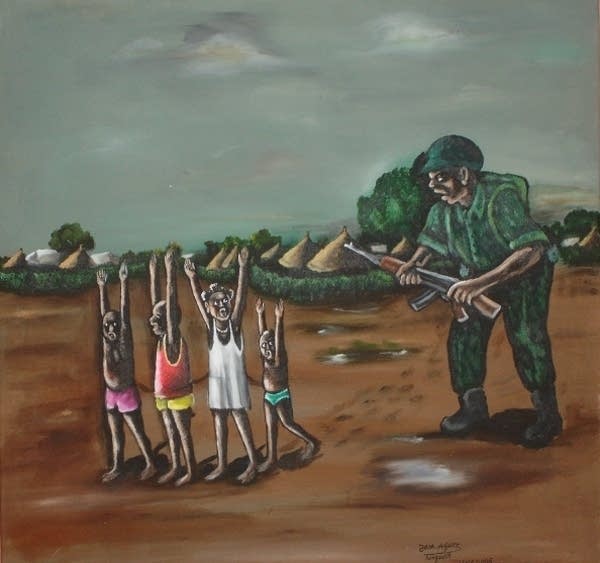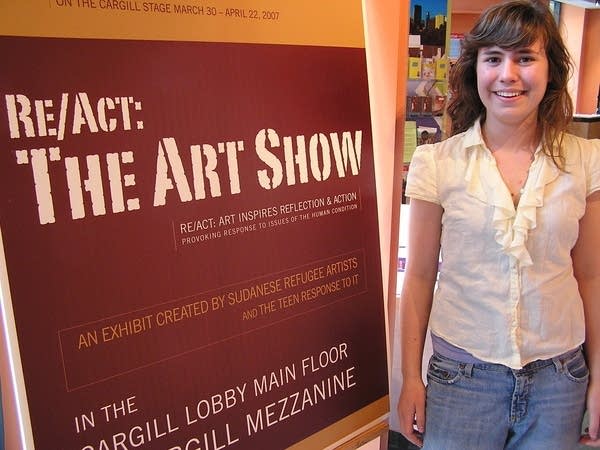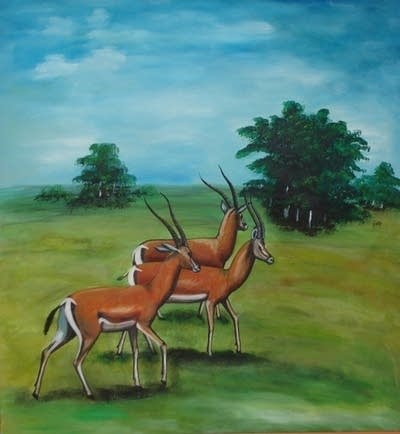Lost Boys inspire local art
Go Deeper.
Create an account or log in to save stories.
Like this?
Thanks for liking this story! We have added it to a list of your favorite stories.

Atem Aleu was five years old when his parents were killed in the Sudanese civil war. Three years later he fled on foot for hundreds of miles with other Sudanese boys, suffering heat, exhaustion, near starvation, and even attacks by lions and hyenas. He first traveled to Ethiopia, but was forced to continue on to Kenya. At the age of 14 he started painting while in a refugee camp there.

"What happened on the journey from Sudan to Ethiopia, what happened to my family and everything came to me as a dream," says Aleu. "And the dream was I had to be an artist to put everything, all that I have in my soul, to put it in pictures, so people can learn something from my paintings."
Aleu now lives in Utah where he continues to paint in an effort to spread awareness about the ongoing humanitarian crisis in Sudan. You can see his paintings, and those of other Sudanese refugees still living in camps in Kenya, up on the walls of the Children's Theatre Company lobby. The paintings are brightly colored. Some portray horrific childhood memories: military men pointing guns and forcing women to take off their clothing, or lions attacking young boys.

But many are cheerful images, depicting peaceful rural scenes with village huts and wildlife. Seventeen-year-old Southwest High School student Elizabeth Richardson says that doesn't surprise her.
Turn Up Your Support
MPR News helps you turn down the noise and build shared understanding. Turn up your support for this public resource and keep trusted journalism accessible to all.
"There's just such a strength and vibrancy in their character and in their resilience," says Richardson, "and you can see that in the joy of the paintings that celebrates the good of life as well as the bad."
Richardson, a student liaison between Southwest High School and the Children's Theatre Company, organized the art exhibit. In addition to the paintings by Sudanese refugees, there are works by Southwest students reacting to the story of the Lost Boys of Sudan. They watched the documentary, which depicts how alien the Sudanese boys felt when they got to the United States. They researched the events surrounding the civil war. And they looked at paintings by the Sudanese refugees. Then they created their own works of art.
The result is a sort of visual dialogue, with the Sudanese saying, "Here is our story" and the students replying, "We hear you and we share your grief."
Student artist Carolyn Bussey created a portrait of a lanky Sudanese boy boxed in to a tiny space, attempting to cook on a miniature stove.

She says she's trying to capture the contortions the refugees must have had to go through to fit into American culture, "because they were so used to being in these villages where they were just open and they had all this free time and time to spend with their friends. The things that they valued were so much different than here in America where it's all 'Get a job, get money, get going.'"
Bussey says learning about the Sudanese experience adjusting to American life made her see her own culture in a new light, with both its good and bad points.

Artist Tina Kise says she knew very little, if anything, about the Lost Boys of Sudan, before her art class took on this exhibit.
"It was terrifying watching the video," says Kise. "I suppose I'm one of those bad people; I kind of shut out anything that isn't pleasant or nice or pretty, and there were a lot of horrifying experiences. Maybe this sounds bad, but I'm really grateful I don't have to do that, that we don't have to be afraid of rebels with guns."
Kise says doing the research for this project gave her a better understanding of who the lost boys are and what they went through. She marveled that their lives were quite different in Sudan, yet their manner of expressing themselves is similar to an American artist--similar lines and use of color.
Sudanese refugee Atem Aleu came to Minneapolis for the opening of the exhibit and the play "The Lost Boys of Sudan" at the Children's Theatre Company. He says he was moved by the work of the students.

"Everything that comes from your soul is very powerful." says Aleu. "I mean, the way they understand it--that's the way we understand it. It's really very powerful because those paintings came from their hearts."
Aleu believes if more people see the artwork, it's more likely there will be peace in Sudan.
The student and Sudanese refugee art exhibit is on display immediately before and after each performance of "The Lost Boys of Sudan" for the length of the show's run at the Children's Theatre Company in Minneapolis.
Dear reader,
Political debates with family or friends can get heated. But what if there was a way to handle them better?
You can learn how to have civil political conversations with our new e-book!
Download our free e-book, Talking Sense: Have Hard Political Conversations, Better, and learn how to talk without the tension.






